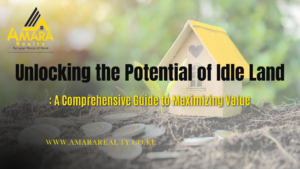
Are you considering how to make the most out of your vacant land? The untapped potential of vacant land offers diverse opportunities for financial gain. Whether strategically located in growing areas or possessing unique features, such as fertile soil or proximity to urban centers, these open spaces can be transformed into profitable ventures. This guide will explore the lucrative opportunities and expert tips on turning vacant land into a profitable asset.
Importance of Strategic Planning for Maximizing Returns
Strategic planning is essential for maximizing returns on vacant land. It ensures a comprehensive evaluation of the land’s features and potential uses. Identifying the most suitable utilization minimizes wasted space, maximizing the overall returns on investment. Understanding market trends and demands enables alignment with lucrative opportunities. Moreover, strategic planning helps in choosing ventures that resonate with current and future market needs, ensuring sustained profitability.
Thorough planning allows for the identification and mitigation of potential risks. Anticipating challenges in advance enables proactive measures, safeguarding investments and ensuring a smoother path to returns. By optimizing financial resources and minimizing unnecessary expenses, returns can be maximized, contributing to overall financial efficiency.
Planning facilitates a structured decision-making process. Timely decisions, based on a strategic roadmap, prevent delays and capitalize on favorable market conditions, enhancing the potential for higher returns. A well-thought-out strategy allows for adaptability in response to dynamic market conditions. Being flexible to adjustments ensures that the investment remains resilient and can capitalize on emerging opportunities for increased returns.
Strategic planning helps in creating a unique value proposition for the land. By identifying and accentuating distinctive features, the land can be positioned to attract the right partnerships, buyers, or tenants, thereby enhancing its overall value. Incorporating sustainability practices into the strategic plan adds long-term value. Aligning with eco-friendly trends not only attracts environmentally conscious stakeholders but also positions the land for potential incentives or subsidies, contributing to enhanced returns.

The location of vacant land is a pivotal factor that significantly influences its profitability. Market demand, accessibility and connectivity, surrounding infrastructure, economic growth in the area, zoning, and development regulations, demographic considerations, environmental factors, and long-term appreciation are critical determinants of its profitability. By carefully assessing and selecting a strategic location, investors can capitalize on market dynamics, demand trends, and the overall growth potential of the area, ultimately maximizing returns.
Tips for Evaluating the Surrounding Area’s Development Prospects
1. Research local development plans to understand the broader vision for the surrounding area.
2. Check zoning regulations to ascertain permissible land uses and understand the flexibility of zoning laws.
3. Evaluate the quality and proximity of existing infrastructure such as roads, utilities, and public transportation.
4. Research local economic indicators including employment rates, job growth, and overall economic stability.
5. Study population growth, demographics, and migration patterns in the vicinity.
6. Evaluate the availability of essential amenities such as schools, healthcare facilities, and shopping centers.
7. Analyze historical property value trends in the surrounding area.
8. Connect with local planning departments or authorities to gather insights into upcoming projects or zoning changes.
9. Monitor recent real estate transactions and development activities in the vicinity.
10. Evaluate the environmental features and sustainability initiatives in the surrounding area.

Zoning laws define permissible land uses in specific areas, ensuring orderly and planned development. They play a key role in urban planning by controlling the density of development in different zones. The laws contribute to the preservation of property values by preventing incompatible land uses. Zoning regulations prioritize public safety and health by preventing hazardous land use in residential areas.
Zoning laws influence the planning and development of infrastructure such as roads, utilities, and public services. They encourage the development of compatible land uses in close proximity. Zoning can be used to promote economic development by designating specific zones for commercial or industrial activities. They provide legal certainty for property owners regarding the permissible uses of their land. Zoning processes often involve community engagement, allowing residents to provide input on the future development of their neighborhoods.
How to Navigate and Leverage Zoning Regulations
1. Familiarize yourself with specific zoning codes and regulations governing the area where the vacant land is located.
2. Schedule meetings or consultations with local planning authorities to gain insights into current and future zoning plans.
3. Consider hiring a land-use attorney or a zoning consultant with expertise in local regulations.
4. Determine if there are opportunities for variances or special permits within the zoning regulations.
5. Attend local planning board meetings or community workshops to stay informed about potential changes in zoning regulations.

Soil analysis, crop selection, sustainable farming practices, irrigation planning, market research, diversification of crops, technology integration, financial planning, networking with agricultural experts, and compliance with agricultural regulations are essential steps for embarking on an agricultural venture. Economic viability, sustainable food production, diversification of income, rural development, environmental stewardship, innovation, and technology integration are key aspects of farming and agriculture as viable options.
Tips for Choosing Crops and Sustainable Practices
1. Select crops that are well-suited to the local climate and soil conditions.
2. Research market trends and identify crops with consistent demand.
3. Implement sustainable farming practices such as organic farming, water conservation, agroforestry, cover cropping, companion planting, integrated pest management (IPM), crop residue management, and conservation tillage.
4. Engage with local agricultural extension services and collaborate with neighboring farmers to collectively enhance the sustainability of agriculture in the region.
The Rise of Renewable Energy and Its Potential
Solar energy farms, wind farms, biomass energy production, geothermal energy exploration, microgrids and distributed energy systems, energy storage facilities, and hydroelectric power generation are potential renewable energy projects that can be explored on vacant land.
Considerations for Solar Farm Development
1. Conduct a thorough site assessment to evaluate the solar potential of the land.
2. Utilize solar resource analysis tools to assess the amount of sunlight the site receives throughout the year.
3. Understand and comply with local regulations governing solar farm development.
4. Confirm land ownership and secure the necessary land rights for solar farm development.
5. Conduct an environmental impact assessment to identify and mitigate potential ecological concerns.

Event hosting, pop-up markets, outdoor concerts and performances, food truck festivals, seasonal attractions, temporary sports or recreation areas, drive-in movie nights, car shows and expos are temporary uses that can be explored for vacant land.
Steps to Market and Manage Such Arrangements
1. Identify your target audience for events or parking services.
2. Establish a website or social media pages to promote upcoming events and parking services.
3. Collaborate with local businesses to cross-promote events or parking services.

Conduct a feasibility study to assess the market demand for smaller parcels in the area. Verify current zoning regulations and local planning requirements. Hire professionals such as land surveyors and real estate attorneys to navigate legal aspects.
Conclusion
In conclusion, vacant land holds immense potential for a variety of profitable ventures such as agricultural endeavors, renewable energy projects, real estate development, event hosting, and more. By strategically planning and leveraging the unique characteristics of the land while adhering to local regulations and market demands, investors can maximize returns and contribute to sustainable development.
This comprehensive guide provides insights into various aspects of making money from vacant land while emphasizing the importance of strategic planning, environmental considerations, community engagement, legal compliance, and market research. With careful consideration of these factors and proactive decision-making, vacant land can be transformed into a valuable asset with diverse opportunities for financial gain.
Whether you are considering agricultural ventures, renewable energy projects or temporary uses for event hosting or parking space, this guide equips you with essential knowledge to make informed decisions and maximize the potential of your vacant land.
In summary, by understanding the importance of strategic planning, assessing the potential of your land, navigating zoning regulations effectively, identifying lucrative opportunities, embracing sustainable practices, exploring renewable energy projects and temporary uses for vacant land, subdividing for sale and effectively marketing such arrangements – you can unlock the true value of your vacant land and realize profitable outcomes.
Remember that each step should be approached with thorough research, professional guidance when necessary, community engagement and a commitment to sustainable practices to ensure long-term success and positive impact on both local economies and environmental conservation efforts.
The possibilities are endless when it comes to making money from vacant land – it’s all about recognizing its potential and leveraging it effectively.
If you have any questions or need further assistance in maximizing the potential of your vacant land for financial gain, feel free to reach out to us at Amara Realty Company Limited. Our team of experts is dedicated to helping you make informed decisions and achieve success in your land investment endeavors.
We hope this guide has been insightful and inspiring as you embark on your journey to make money from vacant land.
Remember – with strategic planning, innovation and a commitment to sustainable development – your vacant land can become a thriving asset with endless possibilities for financial gain.

